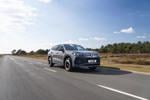THE future of a Nanjing-owned MG Rover is far from clear. In fact, it is far from clear exactly what Nanjing has bought, as arguments over ownership of intellectual property rights rage.
Beaten favourite Shanghai Automotive Industry Corp (SAIC) paid £67 million for the design rights to the Rover 25 and 75 before MG Rover folded in April. SAIC claims that as the MG equivalents – the ZR and ZT – are more than 90% the same, Nanjing cannot make MGs without its permission.
But Nanjing, and administrator PricewaterhouseCoopers, say the rights sold to SAIC were only for the Rover designs, allowing production of MGs to go ahead. Honda is also involved. Last week, it repossessed equipment used to build the Rover 45, which traces its heritage back to the early 90s Honda Civic.
Additionally, former Rover owner BMW still owns the rights to the Rover name.
Nanjing says it wants to take engine production to China while retaining between 1,000 and 2,000 people to build cars in the UK. But, with legal challenges threatening to rise up, the shape and direction of the new MG Rover is shrouded in doubt.
Fleet fears
AS Nanjing Automobile celebrates its successful bid for MG Rover, fleet operators are watching with anticipation to see whether the new owners will honour warranties on existing fleet cars.
Those fleets which bought MG Rover cars before the company’s collapse in April have been left in limbo when it comes to warranties.
Some dealers have been honouring the stricken carmaker’s warranty, but as they are under no obligation to do so, others have not.
David Dippie, the London West regional chairman of the Association of Car Fleet Operators (ACFO), said fleets had been anxiously following developments. He said: ‘I know of a number of ACFO members who have suffered dramatically because of the current situation.
‘If the new buyer was to honour the commitments of the old manufacturer, I’m sure fleets would be very happy.
‘If they won’t – and I suspect they might not want to – it could work against them because it could create a lack of confidence in the future. ‘People will regard them not as the old MG Rover they know and love but as an unknown entity.’
The winner
It said it planned to employ 1,000 to 2,000 people at Longbridge or at a new UK site. Cars would be sold as MG in Europe and possibly Austins in China.
The firm has unveiled plans for five new models. It plans to design, engineer and manufacture MG sports cars and saloons in UK and put finishing touches to small and medium cars imported from China.
It has worked with engineering consultancy Arup, which has an automotive design group that has worked with Rover before.
The losers
SAIC paid £67 million for the designs of the Rover 45 and 75 and the engines, but Nanjing says it did not get ownership of the equivalent MG models, which share 98% of the components. The pair had submitted a bid for about £60 million. They pledged to take on 3,000 people, half in a design and engineering centre developing new models. Cars would have been sold as MG in Europe and Rover in China if BMW (which owns the brand) agreed.
Kimber submitted a £25 million offer for the whole of MG Rover and engine business Powertrain. Initial press reports suggested two bids had come from Kimber, one for just MG and one for MG and Powertrain. But the consortium was encouraged by its investors to make its revised offer. It planned to take on 500 staff to make MGs, with specialist vehicle production for other manufacturers taking the total workforce to 2,000.
Rock-and-roll ride to an uncertain future
The history
THE weekend announcement of a new owner is the latest chapter in the rollercoaster history of MG Rover. Five years ago the future for the manufacturer looked bright.
In May 2000 Phoenix Venture Holdings – John Towers, Nick Stephenson, Peter Beale and John Edwards – paid just £10 for the ailing company and were hailed as heroes when they promised it would rise from the ashes.
BMW had invested £3 billion to try to make a success of the company, but in its final year alone it lost £750 million. Desperate to rid itself of the company, BMW gave the Phoenix Four a £1 billion dowry to revive MG Rover’s fortunes.
They succeeded in reducing debts from £800 million to £77 million, but were still far from profitability and car sales fell year on year. Meanwhile, the Phoenix Four were taking home massive salaries – up to £40 million in pensions, pay and other benefits. In order to succeed in a hugely competitive market they needed to turn out new models, but the money wasn’t available. Facelifted versions of the Rover 25, 45 and 75 fooled few, as they were based on designs that were years old – the 45 was based the Rover 400, itself derived from an early 90s Honda Civic. However, MG variations of the Rover cars did better, as did the facelifted MGF, the TF. The Four tried to find partners, but were turned down by Chinese firm China Brilliance and Malaysian manufacturer Proton. A deal with Indian carmaker Tata was eventually struck to produce the CityRover, but the car was panned. An attempt at a supercar, the carbon-fibre bodied MG SV, sold fewer than 50 units.
By 2004, the losses were continuing to mount and MG Rover was in real trouble. The firm tried again to turn to China and set up talks with SAIC. By November they realised that if the deal didn’t go through they faced bankruptcy.
SAIC agreed to buy the intellectual property rights to Rover designs for £67 million but declined to go further.
In April, SAIC pulled out of the deal and MG Rover collapsed into administration with losses of about £25 million a month and debts of almost £1.4 billion. Longbridge closed with the loss of 6,000 jobs.












Login to comment
Comments
No comments have been made yet.